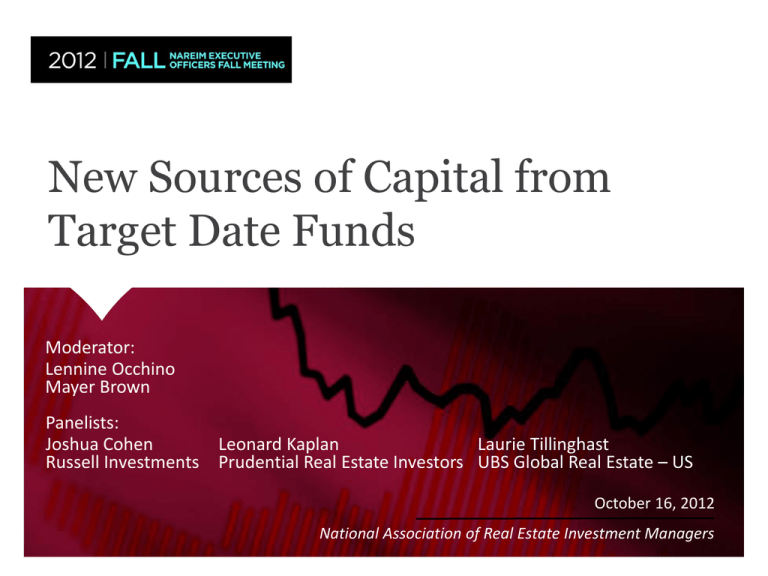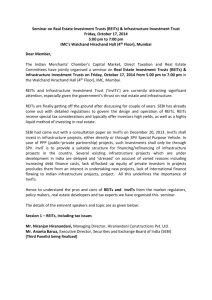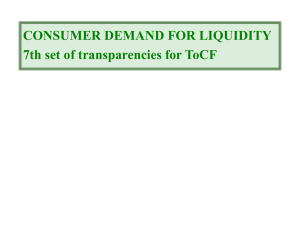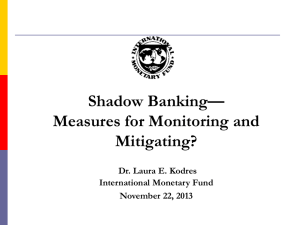New Sources of Capital from Target Date Funds
advertisement

New Sources of Capital from Target Date Funds Moderator: Lennine Occhino Mayer Brown Panelists: Joshua Cohen Leonard Kaplan Laurie Tillinghast Russell Investments Prudential Real Estate Investors UBS Global Real Estate – US October 16, 2012 National Association of Real Estate Investment Managers Distribution of US Private Pension Plan Assets By Plan Type 1975 – 2009 Source: U.S. Department of Labor: Form 5500 Annual Reports 2 Distribution of US Private Pension Plan Contributions By Plan Type 1975 – 2009 Source: U.S. Department of Labor: Form 5500 Annual Reports 3 Custom Target Date Fund Opportunity • Assets in C-TDF about $54bn today – Projected growth to $530bn through 2015 – $450bn + increase next 3 years • Of the $3.7 trillion in TDF assets by 2020 – 37% estimated to be in customized portfolios Approaching $2 trillion in C-TDFs in next 8-10 years Sources: Celent, CaseyQuirk, Morningstar, Consultant firms 4 Fiduciary Considerations in Using Institutional Commercial Real Estate Key Considerations ERISA Risk/Return Prudence Standard of Care. Same as for a Defined Benefit Plan The projected risk/return of the portfolio relative to the objectives of the target date/target risk fund or investment option Diversification Lower correlations with public equities and public fixed investments ERISA 404(c) The Plan must offer participants the opportunity to give investment instructions among “a broad range of investment alternatives” Cash Flow Liquidity and current return of the portfolio relative to the anticipated cash flow requirements of the plan QDIA “applies generally accepted investment theories, is diversified so as to minimize the risk of large losses and that is designed to provide varying degrees of long-term appreciation and capital preservation through a mix of equity and fixed income exposures…,” such as balanced funds and target date funds 5 Sample Target Date Fund Glide Path Source: Russell Investments. For illustrative purposes only. Please remember that all investments carry some level of risk. Although steps can be taken to help reduce risk it cannot be completely removed. 6 Why Custom? Casey Quirk/PSCA April 2009 Survey of 397 plan sponsors. 61% use target date funds as the default. 87% use off-the-shelf target date funds. 13% use custom target-date funds. 7 Russell’s Target Date Asset Allocation (early in glide path) Process depends on client fee sensitivity and risk tolerance 100% 90% 80% 70% 60% 50% 40% 30% 20% 10% 0% Core Portfolio Model Portfolio US Large Cap Equity US Small Cap Equity International Equity Listed Real Assets Core Fixed Income Core Portfolio + Emerging Equity Global Equity Global High Yield 8 Enhanced Portfolio Model Portfolio + Private Real Estate Alternatives Hypothetical portfolios shown for illustrative purposes only. Where does a direct RE product fit in a DC Plan? Direct RE 3-10% of a Diversified, Custom Asset allocation or Real Asset fund Target Custom Target Date Fund Risk Fund Balanced Fund Real Asset Diversified Managed Fund Inflation Fund Account Other Criteria: • Total Plan assets equal or greater than $500M • QDIA is TDF, TRF or Balanced Fund (lifecycle, lifestyle) • Custom (generic name) with “open architecture” • Staff with “DB-like thinking” 9 DC Real Estate Fund: “30,000 Foot View” Record keeper determines NAV C-TDF DC RE Fund NAV determined by RE Manager and/or 3rd Party Private Real Estate Fund(s): 60-100% Overall Fund NAV determined by custodian NAV determined by fund(s) + 10 Liquidity Components: 0-40% (REITs and/or cash) Liquidity Management Managing cash flows and liquidity needs of TDF Managers and Plan Sponsors Plan TDF Real Estate 15% to 40% of Plan Assets 5% to 15% Allocation Cash/REITs 0-40% Private Direct Property 60-100% Credit Line 5-15% Factors to Consider What to ask a Real Estate Manager • TDF Cash Flow • Rebalance methodology • Events that may trigger a material change in cash flows; i.e., reenrollment, new participant enrollment, plan design changes • Are there liquidity queues to get in and/or out of private real estate? • Does the manager deploy a multifund approach or single strategy? • Utilize line of credit or back stop to guarantee liquidity 11 Liquidity Versus Optimal Allocations Liquidity Range 0% 100% Publically Traded REITs Cash/REITs 20-40% Direct Private Property 60-80% • Optimal allocation to produce desired outcome in TDF • Trade off between liquidity and optimal allocation • What is the real liquidity risk? 12 Private Direct Property Valuation Methodologies Range of Approaches Valued In-house • Transparency • Integrity of the internal model • Frequency of change • Conflicts of interest • Organizational confidence in change notification process Partially outsourced to 3rd Parties 1) Individual property appraisals 2) Appraiser review process at Fund level 3) Intra-quarter changes; capital deployed, extraordinary revenue/ expenses 4) Net operating income and changes thereto 13 Valued by 3rd Parties • Materiality levels • Frequency of change • Strength of market database • Organizational confidence in change notification process • Access to accounting records of manager











